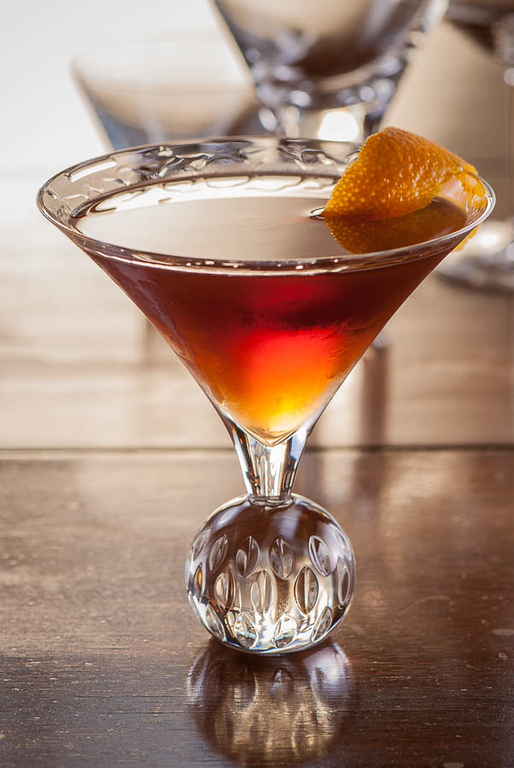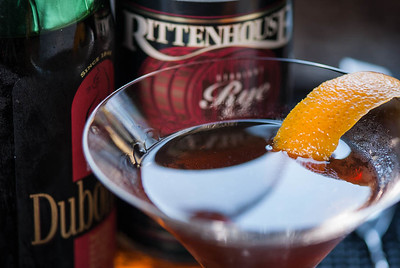If you like Manhattans, but sometimes find them a bit sweet, perhaps the Lafayette Cocktail is your next best friend.
The Lafayette is an embellishment of the “Perfect Manhattan” (sometimes called “Medium Manhattan”), which is a Manhattan with half the sweet Italian vermouth replaced with dry French vermouth. The Lafayette goes a step further, replacing the half-portion of Italian vermouth with Dubonnet Rouge. The result is a drink that is slightly drier than the Manhattan, and with a bit of an edge from the Dubonnet’s hint of quinine.
I have yet to discover the origin of the Lafayette. It appears to be a post-Prohibition cocktail. The earliest recipe I’ve seen so far is from 1948, in David Embury’s The Fine Art of Mixing Drinks. It pleases me to think that the cocktail is a tribute to the Marquis de Lafayette, the French general and hero of the American Revolution. That idea is supported by the Franco-American ingredient list—rye whiskey and French vermouths.

(On the other hand, there is a reference to a drink called the “Lafayette” in the Café Royal Cocktail Book, published in London in 1937, but without a recipe. A British origin makes it seem less likely that the Marquis was the inspiration, but I’m sticking with the tribute story until someone convinces me otherwise.)
The Lafayette Cocktail
- 3 oz Rye Whiskey (Rittenhouse 100, Knob Creek)
- ½ oz French Vermouth (Dolin Blanc, Noilly Prat)
- ½ oz Dubonnet Rouge
- 1 dash Angostura bitters
Stir all ingredients with ice until cold. Strain into a chilled cocktail stem, or over ice in a rocks glass. Optionally garnish with orange.
I prefer the 100-proof Rittenhouse in this drink, but these proportions work just fine with 80-proof ryes.
Dry vermouth is infamous for not combining well with whiskies; the dry is for gin. As Embury puts it:
“…there is always likely to be something wrong, something not quite satisfactory, about a blend either of dry vermouth with whiskey or of sweet vermouth and gin.”

Exception: the Dolin Blanc vermouth retains a bit of sweetness that helps it combine with the whiskey; I recommend it if you can get it. It combines perfectly and transparently, and encourages a sense of smooth lushness in the Lafayette.
(My original recipe listing used the word “dry” for the vermouth, as opposed to Embury’s “French.” Matty points out in the comments below that the Dolin Blanc is not, properly speaking, a “dry” vermouth, and questions if this cocktail made with the Blanc is really a proper Lafayette. It’s an interesting question. My position is that we don’t really know what vermouth was used originally—just “French”—so it probably isn’t out of line to consider Dolin Blanc a legitimate element of the Lafayette. Cocktail naming is always a touchy subject—especially when ingredients straddle the line between rules and guidelines. I welcome your input.)
The Angostura is the only non-French, non-American ingredient in the cocktail, but it is the classic Manhattan bitters, and it works well in this combination.  Chris Weigert, at Urbane, Not Cosmopolitan, has suggested adding a dash of Bittercube Jamaican Bitters #2, which is a pleasant variation if you can get them. They add a complex floral, nutty note to the main whiskey profile. Even better (if you have a Bittercube supplier) is their Bolivar bitters—there’s a note of cinnamon, and a bit more depth than you get from the Jamaican, sort of like adding a full portion of sweet vermouth without the extra sweetness. Give them both a try.
Chris Weigert, at Urbane, Not Cosmopolitan, has suggested adding a dash of Bittercube Jamaican Bitters #2, which is a pleasant variation if you can get them. They add a complex floral, nutty note to the main whiskey profile. Even better (if you have a Bittercube supplier) is their Bolivar bitters—there’s a note of cinnamon, and a bit more depth than you get from the Jamaican, sort of like adding a full portion of sweet vermouth without the extra sweetness. Give them both a try.
(If you find that Dubonnet suits your taste, there are a couple other cocktails you might want to try; I recommend the Deshler and Arnaud’s Special Cocktail.)
“Is the Manhattan too sweet for you? Try the Lafayette Cocktail” at cold-glass.com : All text and photos Copyright © 2012 Douglas M. Ford. All rights reserved.

Of course Dolin Blanc contains a hint of sweetness: it’s not a dry vermouth! Blanc or bianco vermouth is a separate category. (The Dolin line includes a proper dry vermouth, of course.) The blanc may combine well with the whiskey in this cocktail, but you should acknowledge that you’re effectively changing the recipe.
Hi, Matty,
Sticking strictly with “dry” vermouths, I’ve made Lafayettes with M&R Extra Dry and with Noilly Prat French Dry; both worked, though the Spartan qualities of the M&R edged perilously close to Embury’s “something wrong.”
I agree that the Dolin Blanc doesn’t really qualify as a “dry” vermouth, strictly speaking. “White” it is, and “French” definitely, but its sweetness approaches that of some Italian vermouths, so “dry” — not so much.
My only defense for the Dolin Blanc is that the recipe I’m working from—Embury’s—calls for “French vermouth.” (Granted that he apparently didn’t have Dolin’s “Blanc” category to deal with, and so would likely equate “French” with “dry,” but there you have it.) I’ll change the listing to use Embury’s adjective, not the “dry” of my original posting.
Thanks for adding to the discussion here, and for reminding me to be careful with my terminology!
Fair enough! I’m looking forward to trying this recipe, which I’d never come across before. I suspect that I too will prefer it with blanc vermouth. Unfortunately, I can’t get Dolin where I live. The Cinzano and M&R biancos are pretty good, though. Thanks for putting this drink on my radar!
While we’re on the subject of blanc vermouth, I think it’s the key ingredient in another old reciple: El Presidente.
It’s fun to learn that readers found a new cocktail to try, thanks for letting me know. I haven’t tried the M&R Bianco for a long time, I’ll have to refamiliarize myself—thanks for the idea.
I agree about the Presidente, the Blanco is the ingredient that makes it work.
The Franco-American ingredient list, the British reference, and the dates involved lead me to believe that the drink probably has has more to do with the Lafayette Escadrille, the World War I French Air Service escadrille composed largely of American volunteer pilots flying French fighter planes (named, of course, after the the Marquis de Lafayette, so I suppose the reference is there indirectly). Of course I don’t know of any way to confirm that idea either, though it would be interesting to discover the actual source for this drink.
I agree, I’d like to know who did this drink up first—or at least, who gave it prominence. It would be interesting to find the story, but it seems to be lost…
If you like a drier version of the Manhattan, the Brooklyn and its many variants are always worth a try. There’s one called the Bensonhurst that calls for 2 oz rye whiskey, 1 oz dry vermouth, ⅓ oz Maraschino liqueur and 1 bar-spoon Cynar. I didn’t have Cynar when I tried it, so I used Averna instead, and it was quite excellent. I used Noilly Prat, and it seemed to blend very nicely with the other ingredients. I don’t think you would want a bianco vermouth here, not with the maraschino providing the sweetness.
I recall coming across the Bensonhurst some years ago, and somehow just forgot about it, maybe because I couldn’t find Cynar in those days. This time I’ll give it a try, thanks.
Definitely not the same cocktail with ‘blanc’ or ‘bianco’ Vermouth. It may be absolutely delicious, but it would be appropriate to rename it. Embury’s reference to ‘French’ Vermouth is most definitely indicating ‘dry’ vermouth, without a doubt.
Based on your argument, you could’ve just used Dolin Rouge because it is French. Also, similar brix to the Blanc, just minus caramel coloring.
Thanks, Nick. I agree, it’s not a really strong argument, perhaps not defensible at all. But it does make the Lafayette drinkable, where a standard dry vermouth just doesn’t seem to work. I’m still with Embury and his “something wrong, something not quite satisfactory” judgment. I recommend that people try it both ways, and see what works.